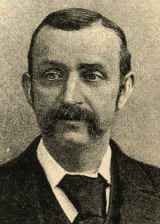
William Wilson (GBR)
Honor Pioneer Contributor (2003)
FOR THE RECORD: Swimming’s First Regular Newspaper Journalist (1860s); First to stress the Need for Scientific Study for Swimming; First to Describe and Illustrate the Racing Start and Turn; Author of Swimming Instructor (1883); First to Analyze Human Movement Through the Water; Originator of the Game of Water Polo.
William Wilson was a visionary and an innovator. He was born in London on 13 November 1844 of Scottish parents who moved from London back to Glasgow when he was a child.
Wilson became a swimmer, a swimming instructor and the sport’s first regular newspaper journalist. He studied the sport carefully and stressed the need for scientific study of swimming, saying that a successful teacher of the art of swimming ought to devote “as much thought, application and constant practice as almost any branch of education or science.”
Wilson had many ‘firsts’: He was the first to describe and illustrate the racing start and turn; the first in literature to advocate an overarm recovery for the side-stroke; he came up with the first lifesaving drill as well as the game of water polo; and he pioneered training methods both on land and in water. With the early stages of swimming pools, he promoted year-round, cold-water swimming in the sea.
Wilson was ahead of his time. He wrote one of the first references in literature to a conscious effort to study and improve swimming methods as opposed to relying on the hitherto natural evolution of the sport. His references to ‘resistance versus propulsion,’ made nearly 120 years ago, still form the fundamental basis on which present-day discussion on stroke mechanics evolve. In his book he discusses using the resistance of water for both propulsion and slowing down.
Wilson described the importance of the relaxing benefits of water. He talked of the importance of swimming in every day life after a hard day’s toil where the bathe cooled and braced him.
Wilson was the first to discuss pool designs and suggested that pool roofs be retractable on wheels so that they could be opened for lengthy periods of time in the summer. He gave details for the first all-year swim clubs for people to bathe every morning whether summer or winter. Water is so invigorating, he recommended breaking the ice to get in each day during the winter months. He was present when members of the West of Scotland Swimming Club, Glasgow, had to walk over ice to get to the water.
Wilson’s book contained the first literary description of turning in swimming. He said that, “touching and turning at the sides or ends of the swimming pond is of such utility in increasing speed, independent of the beauty of the performance, that in trials of fast swimming against time, it is the rule to add a second or two in making up the time for each push. It is owing to the benefit derived from the push at the ends of a bathe that make times faster.” He knew the importance of knowing the length of the pool to know how the time was determined.
Wilson elaborated on the training methods of the day including dryland training. Strokes of that day were leg-dominated and skipping rope was a way in which to strengthen the legs on land. Wilson also understood that physical education was important for the good health of the people. For the first time, Wilson talked about the amount of training necessary to swim races of different distances. For example, for a 100-yard race, it was not out of the question to swim the distance twice a day. If the distance were one or two miles, three times a week would be quite enough. In the first reference to tapering, Wilson made a strong point that the last week of training should be greatly reduced and the last two days should see no hard work at all.
In 1877, Wilson drew up the first set of rules for ‘aquatic football,’ which took place from bank to bank on the River Dee. There were no goal posts and the ball was played between two little flags placed ten feet apart. The game was a rough and tumble scramble. Wilson added goal posts and the game became known as “water polo.” Naturally, rules evolved over the years.
In 1891, Wilson published a number of illustrated articles on lifesaving drills in the North British Daily Mail. He offered the drills to the Swimmers Lifesaving Society and they were printed and circulated in the form of a handbill. In recognition of his valuable services towards the promotion of lifesaving techniques, Wilson was elected the first Life Governor of the Lifesaving Society.
William Wilson was a pioneer in the sport.
Edited from transcript by Cecil Colwin.
